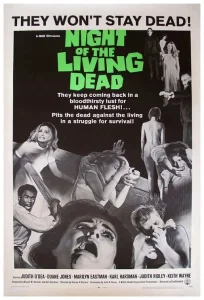How George A. Romero's 'Night of the Living Dead' (1968) Unleashed a Horror Revolution!
In the tumultuous, politically charged year of 1968, as the world grappled with war, civil rights upheavals, and societal unrest, an independent, low-budget film emerged from the backwoods of Pennsylvania that would irrevocably alter the landscape of horror cinema and etch itself into the very fabric of popular culture. George A. Romero's Night of the Living Dead wasn't just another monster movie; it was a visceral, uncompromising, and shockingly realistic nightmare that birthed the modern zombie as we know it, setting the template for countless undead narratives to follow. Stripping away the supernatural allure of classic vampires and the exoticism of foreign beasts, Romero brought horror home, transforming ordinary people into relentless, flesh-eating ghouls who shuffled out of their graves and into our deepest fears. Its gritty, almost documentary-style black-and-white cinematography, its unrelenting tension, and its profound, often subversive, social commentary made it an instant, controversial classic, proving that true terror could be found not just in fantastical creatures, but in the collapse of human order itself.
The film plunges us immediately into a terrifying scenario as Barbra (Judith O'Dea) and her brother Johnny visit a remote cemetery, only to be ambushed by a shambling, reanimated corpse. What quickly ensues is a frantic, desperate fight for survival as Barbra, traumatized and in shock, flees to an isolated farmhouse. There, she encounters Ben (Duane Jones), a resourceful and determined African-American man who quickly takes charge, fortifying the house against the growing horde of "ghouls" descending upon them. As night falls, other terrified survivors emerge from hiding within the house: the argumentative Cooper family (Karl Hardman and Marilyn Eastman as Harry and Helen, with Kyra Schon as their sick daughter Karen) and a young couple, Tom (Keith Wayne) and Judy (Judith Ridley). Trapped together, their desperate attempts to coordinate a defense are constantly undermined by fear, infighting, and the relentless, almost unstoppable, threat just outside their doors.
George A. Romero's direction is a masterclass in minimalist horror, utilizing its tight budget to amplify tension and dread. The black-and-white cinematography, far from being a limitation, enhances the film's grim, stark aesthetic, making the horror feel unnervingly real and immediate. Romero's choice to have the zombies be slow, relentless, and driven purely by instinct was revolutionary, transforming them from mere monsters into a terrifying, anonymous, and ultimately overwhelming force of nature. The film doesn't shy away from graphic violence, portraying scenes of cannibalism and mutilation that were shocking for its time, challenging censorship norms and immersing audiences in its brutal world. Beyond the gore, Romero masterfully builds suspense through the claustrophobic setting, the relentless drumming of the undead against the barricaded doors, and the escalating human drama of the survivors tearing each other apart from within.
Night of the Living Dead was an independent production, famously made on a shoestring budget of just $114,000, but it went on to gross over $30 million, making it one of the most profitable films of its era. It quickly achieved cult status, particularly at drive-ins and late-night screenings, before being recognized as a landmark achievement. The casting of Duane Jones as the intelligent and authoritative protagonist, Ben, was groundbreaking for 1968, subverting racial stereotypes. The film's infamous lack of a copyright notice upon its initial release unfortunately pushed it into the public domain, allowing for countless unauthorized versions and depriving its creators of significant financial returns, yet also contributing to its widespread dissemination and influence. It remains a foundational text, a chilling allegory, and an essential watch for any horror fan, proving that sometimes, the greatest terrors come from the shambling masses, and the fractured humanity, within.
Director: George A. Romero.
Cast: Duane Jones as Ben, Judith O'Dea as Barbra, Karl Hardman as Harry Cooper, Marilyn Eastman as Helen Cooper, Keith Wayne as Tom, and Judith Ridley as Judy.
Special Info/Trivia: The film essentially created the modern zombie archetype, setting standards for their appearance and behavior. It was made on a very low budget ($114,000) but became a massive box office success. Due to a distributor oversight, the film was released without a copyright notice and fell into the public domain, leading to countless unauthorized copies. The casting of a Black actor (Duane Jones) as the intelligent and capable lead was a significant subversion of racial stereotypes for 1968. The film's ending is famously bleak and controversial. It is often cited as a powerful social commentary on the Vietnam War era, civil rights, and societal breakdown.

